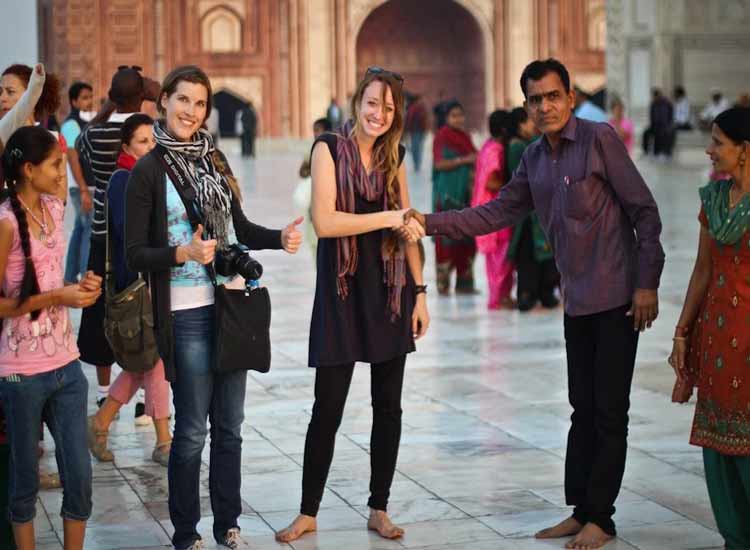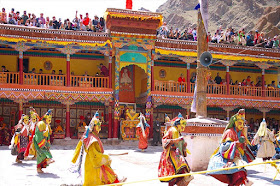India is known to be the land of festivals. And, when summers arrive, they bring along summer vacations. Thus, it is not only about scorching heat but also about happy faces. Summer festivals in India add a fun charter to everyone’s life. Folk dance, music, interesting rituals and people clad in colorful attires light up the groggy atmosphere. Such fairs and festivals offer a sneak-peak into the vibrant culture and heritage of the country.
Here is the list of popular summer festival in India:
1. Gangaur – A flamboyant celebration
One of the most important festivals in Rajasthan, Gangaur is celebrated all around the state but mainly in the ‘Pink City’, Jaipur. It is also celebrated in some parts of West Bengal, Gujarat, and Madhya Pradesh. The festival starts on the day, after Holi and continue for around 18 days. During the festival, married women dress-up in best of their clothes, and worship Goddess Gauri (Parvati), the spouse of Lord Shiva, for a happy married life.
Married ladies and sometimes even unmarried girls keep fast during the festival days. There are processions of camels and elephants, and celebrations with dance, music, food stalls and fireworks on the last day of the festival. It is said that Goddess Parvati came to her husband’s house on this day.
Read More...
Location: Rajasthan, some parts of West Bengal, Gujarat, and Madhya Pradesh.
Dates: According to Hindu calendar, it starts on the 1st day of Chaitra, and continues for 18 days. 30th March – 14th April 2017 and 20th March onwards in 2018.
Highlights: Colorful processions, Goddess worship, and folk dances
2. Baisakhi – Starting of new year
Also known as Vaisakhi, Baisakhi is largely celebrated by people of Sikhism and Hinduism. One of the most popular summer festivals in India, it is commemorated by the harvest of rabi crops by the Punjabi farmer community. On the day of the festival, people adorn themselves in new clothes, visit Gurudwaras, cook lip-smacking delicacies and attend fairs. There is traditional dance and music too like gidda and bhangra performances during colorful processions.
Baisakhi holds religious as well as historical significance. It is mainly celebrated in North India. This was the day in the year 1699 when the order of ‘Khalsa’ was organized by Guru Gobind Singh, the 10th Guru of the Sikhs. Langars are also organized all across.
Read More...
Location: North India mainly Punjab and Haryana
Dates: 13th / 14th April, every year
Highlights: Sowing of rabi seeds, and special fairs
3. Chithirai – Soak-in the spirit of spirituality
An annual festival in Madurai, Chithirai festival is organized at the magnificent Meenakshi Amman temple. Also known as Chithirai Thiruvizha, this festival brings enthusiasm all across the southern region of the country. A grand fair is also organized. There are sparkling processions where golden chariot carrying idols of deities are pulled, accompanied by devotional songs, chants and drum beats. Sweets and incense sticks are also offered.
Other highlights are exciting fair, decorated temples, folk performances and stalls serving street food varieties. This festival is a wonderful amalgam of entertainment and devotion. Stall of shopping at Pudumandapam, a 17th Century monument in the city, are organized. There are a number of rides also. Even the locals dress as gods and various mythical characters.
Read More
Location: Madurai, Tamil Nadu
Dates: 29th April- 5th May
Highlights: Colorful processions, Wedding celebration of Goddess Meenakshi (Parvati) and Lord Sundareswarar (Shiva)
4. Moatsu – A feast of delicious food, fun, and more
Moatsu is a 3-day event that is celebrated in the first week of May by the Ao Naga trial community in Nagaland. This event marks fun, joy, happiness and excitement in the people of the community. On this day, the tribals repair their houses, clear their fields, sow fresh seeds, and clean water wells. There is enthusiasm all around.
During the three days of the festival, there is eating, drinking, tribal music and dance. The main idea is to invoke the blessings of the Lord. People celebrate by making huge groups. Rice beer too is brewed in huge quantities. Tribals adorn themselves in new clothes during the celebrations. The whole atmosphere is relaxed.
Read More...
Location: Mokokchung district villages (Chuchuyimlang village) Nagaland
Dates: 1st – 3rd May
Highlights: The event of Sangpangtu, where a huge fire is lit. Men and kids gather around the fire where they are served with meat and wine by the women.
5. Mount Abu Summer Festival – A miscellany of shades
The only hill town in Rajasthan, Mount Abu bustles with activity during its 2-day event of Mount Abu Summer Festival. With Lake Nakki in the front, the rugged mountains form a wonderful background. The festival is organized by the Tourism Department of Rajasthan and is a treat for cultural aficionados. The atmosphere is wonderful. There are a number of cultural performances, competitions and entertainment options.
The other highlights of Mount Abu Summer Festival are Rajasthani folk music and dance, such as Daph, Ghoomar and Gair dances. Sham-e-Qawwali is a must-attend performance for some soulful music and singing. There are horse races, boat races, CRPF band show, Matka race, puppet shows, and tug-of-war etc. An amazing display of fireworks marks the end of the festival.
Read More...
Location: Mount Abu, Rajasthan
Dates: 9th – 10th May
Highlights: Gair and Ghoomar dance performances, and Sham-e-Qawwali
6. Ooty Summer Festival – A wonderful extravaganza
One of the most popular summer festivals of India, Ooty Summer Festival is a bouquet of various interesting events, organized in the Nilgiris. Some of the highlights are cultural programs, Flower Show, Dog Show, Fruit Show, Vegetable Show, Spice show, boat race, a vintage car rally, painting exhibition, photo competition, hot air balloon show, marathon race, eco-trekking program vintage car rally etc.
The event is organized by the Tamil Nadu Department of Tourism and the National Ministry of Tourism. Competitions and shows are organized at different venues such as Ooty Botanical Garden, Sim’s Park, Government Arts College ground, Nehru Park etc.
Read More...
Location: Ooty, Tamil Nadu
Dates: Month of May
Highlights: Flower show at Ooty Botanical Garden, Competitions and other shows at different venues
7. Yercaud Summer Festival – The Carnival of hues
Celebrated in Yercaud, the 3-day Yercaud Summer Festival attracts locals as well as tourists from all across the state and the neighboring state. Floral arrangements done by the Horticulture Department using more than one lakh flowers is one of the highlights. The venue of this event most of the times is Anna’s Park.
The peaceful towns become lively during this Summer Festival. Some of the highlights are folk dance performances, horse riding, dog shows, flower competition, rangoli competition, photo exhibitions, and cookery contest. Cultural shows are also organized.
Location: Yercaud, Tamil Nadu
Dates: 31st May- 2nd June
Highlights: Floral arrangements made from using 1 lakh flower
8. Shimla Summer Festival – A fiesta in the summer capital
Organized in the month of May/June, Shimla Summer Festival marks the advent of the summer season. The hill town opens its arms to welcome tourists. This is a 10- day festival wherein the town bustles with dance, music, shows and various kinds of competitions. This is an ideal time to get a sneak-peak into the local folk art and music. There are festivities all around.
Some of the highlights of the Shimla Summer Festival are family games poster making competitions, local handicraft exhibitions, ice skating shows, photography contest, flower show, food exhibitions, ice skating competitions, and live theater etc. There are live performances too by local as well as popular artists.
Read More
Location: Shimla, Himachal Pradesh
Dates: May / June
Highlights: Shows, Competitions, and Himachali Film festival
9. Sikkim Summer Festival – The exciting summer celebration
Sikkim Summer Festival is a month-long extravaganza amid the pristine snow-capped Himalayas. Local food festivals, cultural shows, white water rafting in River Teesta, films on Sikkim tourism, Sikkimese folk dances, and local handicraft exhibition. Do not miss attending flower shows to show a display of colorful of primulas, rhododendron, and orchids.
The scenery of Gangtok is going to cast a spell on you. This is the peak flowering season too and thus there is color all around. This is basically a five-day event, alluring people from all across. Get a glimpse of the culture of the state as there are cultural shows also. Bird watching, trekking, and mountain biking are also offered during the Sikkim summer festival.
Read More...
Location: Gangtok, Sikkim
Dates: May
Highlights: Local food festival, Water rafting in Teetsa River, Mountain Biking, Yak safari ride in the outskirts of the city
10. Hemis Festival – Adding colors to the cold desert
The largest and the richest Buddhist monastery in Ladakh, Hemis Monastery every year hosts Hemis festival, one of the most popular summer festivals in India. This 2-day event is a state holiday and falls on the 10th day of the Tibetan lunar month. It is also the birthday of the founder of Tibetan Buddhism, Padmasambhava. During the event, people dress themselves up in traditional attire. While women wear lots of jewelry and colorful headgears, men wear cummerbunds.
One of the prime attractions is Cham dance, which is a sacred masked dance performance, done by the lamas. Their dance is accompanied by cymbals, long horns, and drum beats. This performance is linked to Tantric form of Buddhism.
Read More
Location: Hemis Monastery, Ladakh
Dates: July
Highlights: Chams dance or Mask dances by lamas of the Monastery
Related Post:
Best Places to go for Summer Holidays in India
Top summer destinations in India


























